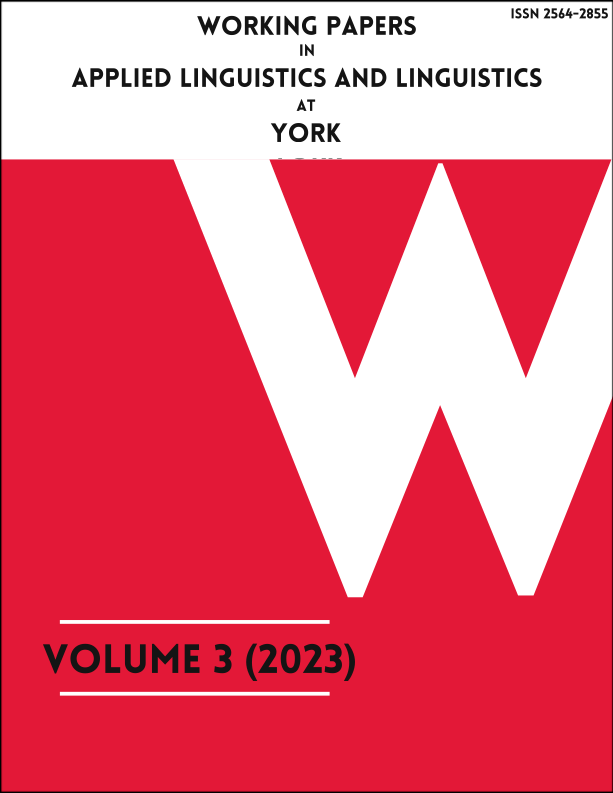Vocabulary in urban contexts using multimodality
A pedagogical proposal
DOI:
https://doi.org/10.25071/2564-2855.28Keywords:
language education, multimodality, vocabulary teaching, collaborative learning, technology-mediated language learningAbstract
This is the presentation of a new pedagogical tool. The tool is an alternative to the usual presentation of vocabulary focusing on some key concepts: multimodality, theory of space, and collaborative learning. Considering that the study of foreign languages has the difficulty of studying cultural elements that are usually not present in the life of the students, this paper will propose an activity to study vocabulary in a contextualized space. The objective is to understand social spaces through discovering lexical items in a natural environment, using the observation and description of urban photographs, which represents a change to the traditional way of presenting vocabulary. Through a collective and technology mediated process, the students create a multimodal artifact that can be shared with other students. The process of learning occurs, first, from the production of the artifact, and second, from the presentation and exchange of the artifacts produced among students.
References
Amin, A. & Thrift, N. J. (2002). Cities: reimagining the urban. Polity.
Barrallo Busto, N., & Gómez Bedoya, M. (2009). La explotación de una imagen en la clase de E/LE. Revista Electrónica de Didáctica ELE, 16. https://www.educacionyfp.gob.es/dam/jcr:19942320-87bd-4889-821e-77b2831ab48c/2009-redele-16-01barrallo-pdf.pdf
Benson, P. (2021). Language learning environments: spatial perspectives on SLA. Multilingual Matters. DOI: https://doi.org/10.21832/9781788924917
Cruz Piñol, M. (2015). Léxico y ELE: enseñanza/aprendizaje con tecnologías. Journal of Spanish Language Teaching, 2(2), 165–179. https://doi.org/10.1080/23247797.2015.1105518 DOI: https://doi.org/10.1080/23247797.2015.1105518
Domínguez González, M. (2020). TIC que favorecen la integración del aprendizaje de las competencias en español como lengua extranjera [MA Thesis]. Universidad de Jaén.
Dronjic, V. (2019). How (not) to teach english vocabulary. The CATESOL Journal, 31(1), 29–54.
Fernández Alonso, R., Lloro Javierre, J., Montes Garcés, E., & Pascual-Salcedo Sáez, M. (2021). El español en Canadá. In CVC. Anuario 2021. El Español En El Mundo. Centro Virtual Cervantes. Retrieved September 27, 2023, from https://cvc.cervantes.es/lengua/anuario/anuario_21/america/canada.htm
Guichon, N. & Cohen, C. (2016). Multimodality and CALL. In The Routledge Handbook of Language Learning and Technology (pp. 535–547). Routledge. https://doi.org/10.4324/9781315657899-52
Haines, K. (2015). Learning to identify and actualize affordances in a new tool. Language Learning & Technology, 19(1), 165–180. http://dx.doi.org/10125/44407
Hostetler, L. (2014). Street photography. In Oxford Art Online. Oxford University Press. https://doi.org/10.1093/gao/9781884446054.article.T2254150 DOI: https://doi.org/10.1093/gao/9781884446054.article.T2254150
Kennedy, L., Нааман, М., Ahern, S., Nair, R. R., & Rattenbury, T. (2007). How flickr helps us make sense of the world. International Multimedia Conference: Proceedings of the 15th International Conference on Multimedia, 631–640. https://doi.org/10.1145/1291233.1291384 DOI: https://doi.org/10.1145/1291233.1291384
Lightbown, P. & Spada, N. M. (2013). How languages are learned (Fourth edition.). Oxford University Press.
Madej, A. (2015). La fotografía como medio didáctico en la clase de ELE. In XLIX Congreso Internacional de la Asociación Europea de Profesores de Español (AEPE), 239–252. https://cvc.cervantes.es/ensenanza/biblioteca_ele/aepe/pdf/congreso_49/congreso_49_25.pdf
Martín Peris, E. (Director). (2008). Diccionario de términos clave de ELE. Instituto Cervantes - SGEL. https://ci.nii.ac.jp/ncid/BA88521103
Murray, S. (2008). Digital images, photo-Sharing, and our shifting notions of everyday aesthetics. Journal of Visual Culture, 7(2), 147–163. https://doi.org/10.1177/1470412908091935 DOI: https://doi.org/10.1177/1470412908091935
Nation, P. (2020). Is it worth teaching vocabulary? TESOL Journal, 12(4). https://doi.org/10.1002/tesj.564 DOI: https://doi.org/10.1002/tesj.564
Nation, P. (2022). Learning vocabulary in another language. Cambridge University Press. DOI: https://doi.org/10.1017/9781009093873
Paivio, A., & Sadoski, M. (2010). Lexicons, contexts, events, and images: Commentary on Elman (2009) from the perspective of dual coding theory. Cognitive Science, 35(1), 198–209. https://doi.org/10.1111/j.1551-6709.2010.01146.x DOI: https://doi.org/10.1111/j.1551-6709.2010.01146.x
Richards, J. C., & Rodgers, T. S. (2001). Approaches and methods in language teaching (2nd ed.). Cambridge University Press. https://doi.org/10.1017/CBO9780511667305 DOI: https://doi.org/10.1017/CBO9780511667305
Sadoski, M. (2005). A dual coding view of vocabulary learning. Reading & Writing Quarterly, 21(3), 221–238. https://doi.org/10.1080/10573560590949359 DOI: https://doi.org/10.1080/10573560590949359
Sánchez Rufat, A. & Jiménez Calderón, F. (2015). New perspectives on the acquisition and teaching of Spanish vocabulary. Journal of Spanish Language Teaching, 2(2), 99–111. https://doi.org/10.1080/23247797.2015.1106123 DOI: https://doi.org/10.1080/23247797.2015.1106123
Sanz, C. (2016). Enseñanza del Español como lengua extranjera: Pedagogía y tecnología. In J. Gutiérrez-Rexach (Ed.), Enciclopedia de Lingüística Hispánica (pp. 432–441). Routledge. https://doi.org/10.4324/9781315713441 DOI: https://doi.org/10.4324/9781315713441-112
Downloads
Published
How to Cite
Issue
Section
License
Copyright (c) 2023 Camila Gonzalez Bravo

This work is licensed under a Creative Commons Attribution-NonCommercial 4.0 International License.
You are free to:
- Share — copy and redistribute the material in any medium or format
- Adapt — remix, transform, and build upon the material
Under the following terms:
-
Attribution — You must give appropriate credit, provide a link to the license, and indicate if changes were made. You may do so in any reasonable manner, but not in any way that suggests the licensor endorses you or your use.
-
NonCommercial — You may not use the material for commercial purposes.
- No additional restrictions — You may not apply legal terms or technological measures that legally restrict others from doing anything the license permits.



